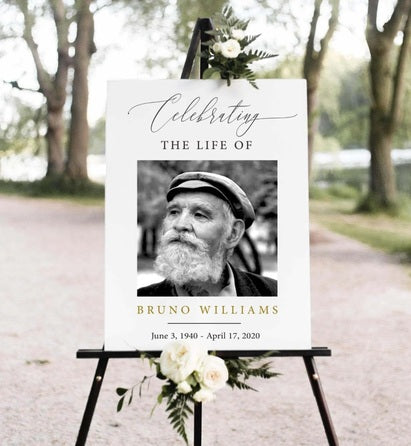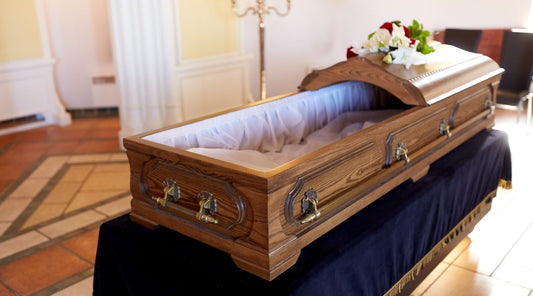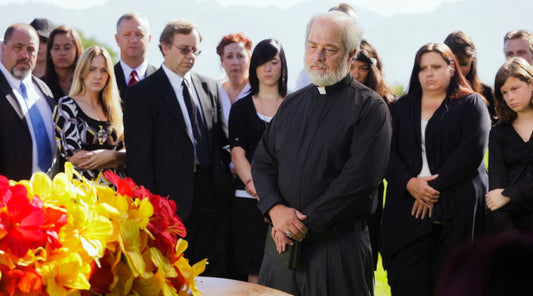
How to write an Obituary Template - step by step guide.
Encountering the passing of a loved one can often be an overwhelming experience. Planning a funeral, dealing with grief, supporting family, and informing friends it's a lot to take in.
But, gathering your thoughts, accepting grief, and celebrating the past life can bring closure. An obituary gives you this opportunity to express the experience in a meaningful way.
However, writing an obituary demands care and honesty. But you still need to maintain the norms of propriety and decency. Done right, it can serve two purposes:
- The announcement of grief with a departed loved one.
- The celebration of a precious life lived.
We want to help you cover all the appropriate information and still make it a meaningful tribute. So, we'll take a comprehensive step-by-step guide. Here's an overview of what we'll cover:
- Creating an Obituary Template (Step by step guide)
- What not to include and things to avoid
- Short obituary examples and obituary templates
- Final Tips

What is an Obituary?
An obituary is a written statement describing a person who is passing away. Typically, these announcements include a minimal photo of individuals and highlights of their death achievements and personality. If a service is open to the public, you may wish to add this information to your funeral. Historically funeral papers are published by newspapers. The digital media also have digital websites that offer funeral information announcements. You may also want to make a funeral home's website available to you for viewing and posting of your death's obituaries.
How do you write an Obituary Format? (Step by step guide):
Obituaries can vary according to context. You decide how much to disclose, inform, and announce. Remember that obituaries can be as short as a few lines or as detailed as an entire page.
We'll cover the standard methods. But we'll also cover those elements you can use to create a more meaningful obituary. Then, you can create an obituary template using the outline given here.

Step 1: Gathering Basic Information
First things first. You will need to collect and be ready with some basic information and details. In most instances, you will need to have the full name of the deceased. This can include:
- First name
- Middle name(s) or Maiden name(s)
- Last name
An obituary also usually contains the date of death and date of birth. There are exceptional cases where the birthday is not mentioned (Eg. Birth date and birth place not known, family members wish not to disclose, etc.).
You may also need to add information regarding the funeral program. So, you can mention if there will be no funeral services or basic details about when and where it will be held. These are all basic fill information that's part of any standard obituary.
Step 2: Information on Passing/Death
Next, you'll have to clearly announce that the person has died. After all, this is the essence of the obituary.
Here, you can choose to disclose or withhold specific information about the death. This can include the time, place, age, cause of death, etc. . But, anyone writing an obituary must remember that these details are not mandatory in any way.
You can use different terms to communicate the person's passing. For instance, here are some phrases that can work in different contexts:
- 'passed away,'
- 'left for heavenly abode,'
- 'left this world,'
- 'finished his/her journey,'
- 'run the race,'
- 'met an untimely demise,' etc.
Step 3: Biographical Information and Life Events
While obituaries are often sad announcements, they can also be meaningful tributes. A good way to do this is to provide a wholesome bio of the deceased person's life.
Anything that fondly reminds you of the deceased person can find a place here. Here are a few examples of biographical information in obituaries:
- Early life and childhood.
- Education qualifications
- Job title, Occupation(s) and profession(s).
- Marriage and retirement.
- Small anecdotes, memorable moments, and important events of the person's life.
- Community, social, or military service, awards, etc.
- Things that moved or brought joy to the deceased while alive.
As you can imagine, this is an indefinite list that can expand based on how you want to remember and celebrate the person's life. But you need not feel obligated to include these elements in the obituary.

It is also vital to remember that sharing detailed identity information can be risky in today's day and age. But we'll get into more detail regarding these risks further below.
Step 4: Information on Family members and kin
If you want a short and simple format, you may mention only the deceased's, family members. (Eg. 'He is now survived by his wonderful wife and three children).
For a longer and more detailed obituary, you can add the names of family members that preceded or succeeded the deceased in life. Here too, you can mention the surviving spouse and surviving children. Oftentimes, obituaries may mention both immediate family information and extended family too.
Although this is not a full list, here are examples of family ties and relationships that may appear in obituaries.
- Immediate family, spouse children, children's names.
- A step child or adopted child
- Parent's names and grandchildren's names.
- Great-grandchildren and great-great-grandchildren (If the family size is exceptionally large).
- Paternal and maternal grandparents, great grandparents, etc. (If of notable lineage)
As you can deduce, many of these family ties and relationships aren't completely necessary. However, you can make a mention of notable relationships of the deceased if you want. For instance, '...Mr. A was the great-grandson of author and patriot Mr. B (Notable personality)'.
Step 5: Funeral Information and Memorial Service
Finally, it's also appropriate to mention whether or not there will be a funeral program. You can use the obituary to announce that there will be no funeral program if the deceased or the family wished so.
If there is indeed a funeral program, you may choose which important details to include. Depending on the situation, you can add the following details regarding the funeral:
- Funeral home (if specific location must be informed to attendees).
- Funeral service times.
- Order of memorial service
- Memorial website (if further details to be announced)
- Other details of the planned funeral if necessary.
So, there you have it! This basic yet comprehensive set of steps can serve as a blank obituary template that you can build on.
To make sure that you get the words right, it may be helpful to go through a few things that you may need to avoid.

What should you not include in an obituary?
Many people face the trouble of having to re-write and redo obituaries. Many people do not know what to to say and how to impress condolences. This, too, after they had already started writing their obituary template or initial draft. To ensure that you get things right on the first try, we include some elements that you can avoid.
Don't make it too personal
Avoid over-sharing or adding too many personal elements to the obituary. After all, it's for everyone who has access to the newspaper, website, or social media post. We all have strained relationships we are not proud of. But an obituary is not the place to vent those feelings. Keep it courteous, respectful, and informative.
As long as you mention the required information, the personal stories can wait till the funeral or family gathering as a special message.
Choose what to share about deceased and funeral service.
Personal details shared in public can easily become vital information for identity theft and scamming vultures.
For instance, the first name, mother's maiden name, or full date of birth are crucial details used commonly in online profiles. With the right information, a hacker can simply fill in the blanks and misuse the information.
A newspaper obituary can easily become clumsy if too much unnecessary information gets packed into it. For example, you need not talk of funeral arrangements like who the funeral director is or add special messages from loved ones. That would make it an obituary program of sorts.
Other details of deceased person's life
Although the biographical section is a good way to celebrate a loved one's passing, it's not an obligatory element. Sometimes short obituaries can serve the purpose. That way, you reserve the personal details for other memorial programs for the deceased.
If you've seen other obituaries where they mention ex-spouses or ordinary qualifications, you know exactly how it looks.
Additionally, you can include some In Loving Memory Quotes or Condolence Messages.
Obituary Templates and Samples:
To start you off correctly, here are a few sample obituaries and free obituary templates you can use.
Short Obituary Example
"Through this column, we would like to inform that [First name + Last name], aged [number], residing at [residence] passed away on [full date] from [cause of death] (cause of death is optional).
[He/She/First name] is survived by [relevant list of the family]"
Standard Obituary template
"[Full name], aged [number], residing in [residence] passed away on [Date of death], from [Cause of death].
[First name], born on [Birthday], grew up in [Hometown] and studied [Education] at [Institution]. He/she went on to major in [Subject] at [Institution] before landing a job as [title] at [Company].
At the age of [number], he/she married [Spouse's first name], and went on to have [number] beautiful children. [First name] lived a full life, often enjoying [passions/hobbies] and achieving [accomplishments] in [field].
He/she is survived by [living spouse] and [number] grateful children."
Short Obituary Samples for Specific Contexts
There are several ways you can celebrate or pay respects to the deceased through the obituary program. Accepted forms of describing the person could be
- 'A loving father and husband,'
- 'An accomplished woman, wife, and mother'
- 'A citizen par excellence
When mentioning how he/she died, you can describe the passing as a result of a long fight against [disease/illness].
Final Note
You can use any of the steps and formats here as a free obituary template that's open to further editing. An obituary program is neither a legal document nor a eulogy. A good obituary combines honesty, decency, and sometimes, a bit of fun, to inform and announce the passing of a loved one. Not more, not less!
Blog Author: Tim


